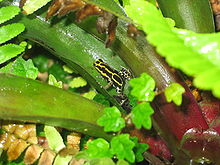Ranitomeya variabilis
Zimmermann's poison frog, variable poison frog, or splash-back poison frog (Ranitomeya variabilis) is a frog. It lives in the Amazon rainforest in Peru, Colombia, Ecuador, French Guiana, and Brazil.[2][3][1]
| Ranitomeya variabilis | |
|---|---|

| |
| Scientific classification | |
| Domain: | Eukaryota |
| Kingdom: | Animalia |
| Phylum: | Chordata |
| Class: | Amphibia |
| Order: | Anura |
| Family: | Dendrobatidae |
| Genus: | Ranitomeya |
| Species: | R. variabilis
|
| Binomial name | |
| Ranitomeya variabilis (Zimmermann and Zimmermann, 1988)
| |
| Synonyms[2] | |
| |
Body
changeThe adult male frog is about 17.4 mm long from nose to rear end and the adult female frog is about 18.0 mm long. The skin of the frog's back is yellow-green on the head and front and blue-green near the rear end. It has a spot on its nose. There are small spots on the legs. It has these colors to tell other animals that it is poisonous. This is called aposematic coloration. Its poison is made of alkaloid molecules.[3]
Home
changeThis frog lives in trees in rainforests that have never been cut down and rainforests that have been cut down and are growing back. It lives in forests that are not too high up in the mountains. People have seen this frog between 75 and 1650 meters above sea level.[1]
Young
changeThe male frog finds a high plant to sit on and calls to the female frogs. His voice sounds like a buzz. When a female comes near him, the male leads her to a good place to lay eggs. The female frog lays eggs in pools of water in bromeliad plants. Sometimes they lay eggs in holes in trees that have water in them. She lays 3-6 eggs at a time. After the eggs hatch, the male frog carries the tadpoles to different pools of water.[1][3]
Only the male frog takes care of the tadpoles. Unlike other species in Ranitomeya, the female does not lay eggs for the tadpoles to eat. The tadpoles eat what they find there, for example tadpoles from other frogs in Ranitomeya.[3]
Danger
changeScientists believe this frog is not in danger of dying out because it lives in a large place. But it is in some danger because people cut down trees to make farms and get wood to build with. People also catch this frog to sell as a pet.[1]
Some of the places this frog lives are protected parks.[1]
First paper
change- Zimmermann H; Zimmermann E (1988). "Etho-Taxonomie und zoogeographische Artengruppenbildung bei Pfeilgiftfroschen (Anura: Dendrobatidae)". Salamandra. 24: 125–160.
References
change- ↑ 1.0 1.1 1.2 1.3 1.4 1.5 IUCN SSC Amphibian Specialist Group (2023). "Zimmermanns' Poison Frog: Ranitomeya variabilis". IUCN Red List of Threatened Species. 2023: e.T55207A85886856. doi:10.2305/IUCN.UK.2023-1.RLTS.T55207A85886856.en. Retrieved June 26, 2024.
- ↑ 2.0 2.1 Frost, Darrel R. "Ranitomeya variabilis (Zimmermann and Zimmermann, 1988)". Amphibian Species of the World, an Online Reference. Version 6.0. American Museum of Natural History, New York. Retrieved June 20, 2024.
- ↑ 3.0 3.1 3.2 3.3 "Ranitomeya variabilis (Zimmermann & Zimmermann, 1988)". AmphibiaWeb. University of California, Berkeley. Retrieved June 26, 2024.
